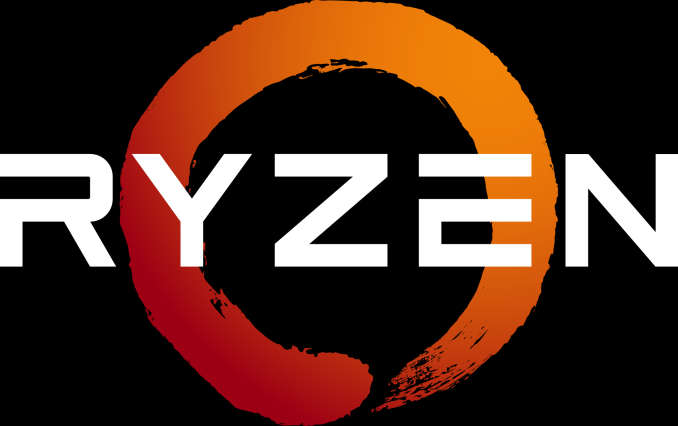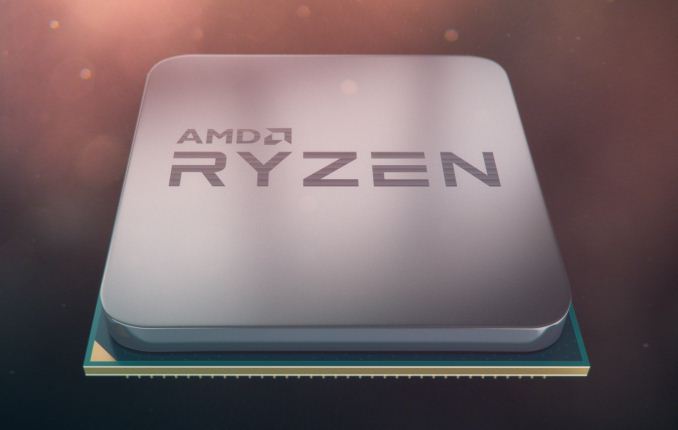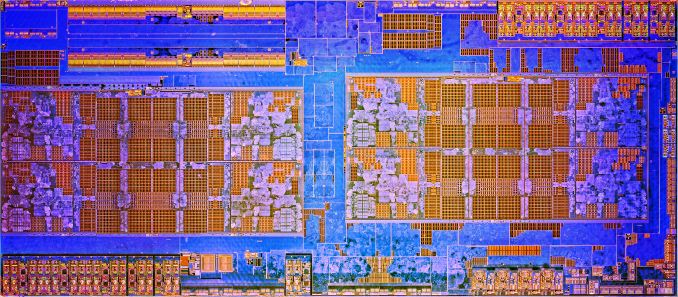AMD Launches Ryzen: 52% More IPC, Eight Cores for Under $330, Pre-order Today, On Sale March 2nd
by Ian Cutress on February 22, 2017 9:00 AM EST
The biggest x86 launch for AMD in five years is today: Ryzen is here. As always before a major launch, AMD gives a ‘Tech Day’ for relevant press and analysts, and through this event AMD’s CEO, Dr. Lisa Su lifted the lid on one of the most anticipated products in the semiconductor industry. AMD knows how to control the level of enthusiasm for its fans, and today is the end result, with processors going on pre-order from major retailers today at 1pm EST, ready for a general hard launch on March 2nd.
In a similar vein to launches of recent smartphones, AMD is doing a staggered announcement/launch with the products on their new microarchitecture. Where Samsung/Apple might give all the details for a product a few weeks before it’s available to buy, today on February 22nd marks the day where AMD is giving consumers information about Ryzen, and specifically the Ryzen 7 family of eight-core products. All the information today is from AMD, and AMD’s internal testing, and pre-orders also start from today for users ready to put down their money for a launch day part. Reviews of the CPUs, as well as when the CPUs will ship to customers, is on March 2nd. This also happens to be right in the middle of two annual shows, Game Developer Conference (GDC) and Mobile World Congress (MWC), making the time between receiving pre-launch samples and being able to provide independent verification of AMD’s performance claims relatively frantic. We’ll do our best!
The Ryzen Family
With a new processor launch, naming the parts and positioning them within the market is critical. So with Ryzen, the processor stack will be split into three based on performance and price: Ryzen 7 at the high end, Ryzen 5 in the middle, and Ryzen 3 for more price-conscious consumers. Both Ryzen 5 and Ryzen 3 are set to be launched later, and Ryzen 7 is the first portion of the family to be released.
Ryzen 7 will have three CPUs to start, all having eight cores and supporting simultaneous multi-threading:
- Ryzen 7 1800X: 8C/16T, 3.6 GHz base, 4.0 GHz turbo, 95W, $499
- Ryzen 7 1700X: 8C/16T, 3.4 GHz base, 3.8 GHz turbo, 95W, $399
- Ryzen 7 1700: 8C/16T, 3.0 GHz base, 3.7 GHz turbo, $329
Ryzen 7 1800X will be the high-end part, featuring a base clock of 3.6 GHz and a turbo of 4.0 GHz, within a TDP of 95W, and for $499. Next to this is Ryzen 7 1700X, launching at $399, with a base/turbo of 3.4/3.8 GHz. The final part for the launch is the Ryzen 7 1700, providing eight cores and sixteen threads for $329 at 3.0/3.7 GHz frequencies.
Processors will initially be available for pre-order from 185 retailers and OEMs worldwide, either as individual parts or pre-built systems.
What, not 40% IPC? 52% IPC??
Enthusiasts and analysts use the term IPC, or ‘Instructions Per Clock’, as a measure of how much the underlying microarchitecture improves from generation to generation. Two decades ago, a good design on a smaller node could net a healthy double-digit gain, whereas in recent years 5-10% gain has become the norm. When AMD initially announced that the new Zen microarchitecture they were developing was aiming for a 40% IPC gain, despite the low IPC they were starting from, users remained skeptical. AMD rehired Jim Keller to work alongside long-term AMD architect Mike Clark and produce a team with several goals in mind: high-performance x86, simultaneous multithreading, and a product to be relevant in the computing, PC, server and mobile space again. So despite this, 40% IPC always seemed a somewhat lofty goal, because Bulldozer was so underwhelming, and despite this low starting point. For the Ryzen launch today, AMD is stating that the final result of that goal is a 52% gain in IPC.
This is something we will need to test in due course!
The Ryzen Silicon, and the Future
AMD pointed out that the new 8-core silicon design runs 4.8 billion transistors and features 200m of wiring. Through previous announcements we’ve examined parts of the microarchitecture including cache sizes, threading, front-end/back-end design, and so on.
AMD Zen Microarchiture Part 2: Extracting Instruction-Level Parallelism
AMD Gives More Zen Details: Ryzen, 3.4 GHz+, NVMe, Neural Net Prediction, & 25 MHz Boost Steps
AMD’s CEO was keen to point out that this is a from-scratch design for AMD, using the knowledge gained from features developed for previous products but ultimately under the hood it looks like ‘a typical x86 high-performance core’, with AMD-specific features and tweaks. We were told that AMD’s roadmap extends into the multi-year range, so while the focus for 2017 will be on this family of products, back at HQ the next two generations are in various stages of development.
BENCHMARKS PLEASE
So despite the 82+ motherboards going to be available, 19 initial PC system builders moving into 200+ through the first half of 2017, the big question on everyone’s lips is how exactly does it perform?
Well, AMD gave us the following numbers:
AMD's benchmarks showed that the top Ryzen 7 1800X, compared to the 8-core Intel Core i7-6900K, both at out-of-the-box frequencies, gives an identical score on the single threaded test and a +9% in the multi-threaded test. AMD put this down to the way their multi-threading works over the Intel design. Also, the fact that the 1800X is half of the price of the i7-6900K.
In a similar vein, again with the Cinebench 15 multi-threaded test, the Ryzen 7 1700X scores over and above the Core i7-6800K (its price competition) and higher than the Core i7-6900K which costs 2.5 times as much.
We’ll tell you what our benchmarks say, with official retail processors. But you will have to wait until March 2nd. Sorry.





















386 Comments
View All Comments
stockolicious - Wednesday, February 22, 2017 - link
"Also remember Intel has a lot of brand cache"no they dont - its a "myth" - intel has always, for the most part, had better products. Intel makes semiconductor chips which are a "Commodity" AMD didnt get all of the console business because of their brand - its because Sony and MSFT put them in there. AMD needed a reason for a builder to use them - well now they have and we will see that chips are just a commodity. :)
dcbronco - Wednesday, February 22, 2017 - link
I think servers will start switching the second these chips show stability. The difference in power consumption and price makes it a no brainer. The 30+% power savings per month alone makes it a win. AMD can simply make insurance contracts on the chips and any short of catastrophic failures beats what Intel can offer.Fallen Kell - Wednesday, February 22, 2017 - link
I'm sorry but I dont see companies switching their servers over unless you can use multiple cpus in a single system, which is not a feature that I have seen announced in the press releases. What company is going to purchase 4-8 AMD servers when they can get a dual or quad CPU Intel server with 16 or 20 cores per CPU? The overhead of needing the extra computers negates any price savings of the cpu.fanofanand - Thursday, February 23, 2017 - link
With contracts switching to "per core" beefier cores may be the route companies end up going. The actual processor price is a minimal cost, it's the energy consumption and software licensing that's the killer.Cooe - Sunday, February 28, 2021 - link
Uhhh... Dual socket Zen CPU's were annouced months before this event.iwod - Wednesday, February 22, 2017 - link
Edging closer to 70% of the PC market are mobile. Where AMD wont be competing in it for another year, and Intel going mobile first meaning 10nm Intel Mobile CPU wont have any competition in performance /watt until AMD moves to 7nm, late 2018 or likely 2019.Within the Desktop PC segment, most aren't even in the Ryzen 7 prices range, they are Pentium price range, which AMD's APU compete against, and not coming anytime soon.
So could Intel afford to cut 40% of their desktop line, of course they can. And heck I am sure Intel's brand name is worth some money so even a 20% price drop in the perfect scenario of AMD's launch will still be enough.
Meteor2 - Wednesday, February 22, 2017 - link
^^This. I'm super-pleased AMD are sticking it to Intel in the desktop space... But my next computer purchase is going to be a x86 2-in-1. And that means Core M, quite possibly a Cannon Lake 10 nm part. I'm not aware of a roadmap from AMD for 5W parts. Only desktop CPUs, and I vaguely recall something around APUs. That's great n all... But so few desktops are sold these days.Haawser - Wednesday, February 22, 2017 - link
Zen APUs with Vega graphics are in second half of this year. Confirmed (again) by Lisa Su yesterday.Murloc - Wednesday, February 22, 2017 - link
let's see the 5 parts first, those are the ones that matter, the performance level of these parts is way above what the average computer or even gaming computer features.I'm sure the intel margin is thinner on those and the picture won't be as stark.
kadajawi - Wednesday, February 22, 2017 - link
Well... it's not that clear cut. Most Intel CPUs have integrated graphics, and while it's nothing to write home about, it isn't terrible either, and will be more than enough for most users. Yes, you could buy a Ryzen 3 instead of an i3, and it will be cheaper (the CPU that is, the motherboards I've seen so far don't seem to be significantly cheaper?), but you'll have to buy a graphics card too. Even a crappy entry level card will eat into the price advantage.For gamers it's a no-brainer, of course. But if you're a programmer that needs a beefy CPU but couldn't care less about the graphics card? Even in media creation the graphics card is of limited importance (it's getting more and more important, but so far...).